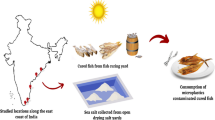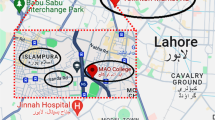Abstract
Preservation of a healthy environment is a very important task, especially in the time of the total industrial revolution. Therefore, attempts to find new additional biomarkers of contamination are welcomed. For this aim, the functional and antioxidant properties of mussel Mytilus galloprovincialis proteins and the heavy metals Cd and Pb were explored. Mussels were collected in contaminated and noncontaminated sites in the Varna area of the Bulgarian Black Sea coast. Proteins were extracted from mussel entire soft tissue and analyzed using instrumental (Fourier transform infrared [FT-IR] spectroscopy, fluorescence, atomic absorption spectrophotometry), and biochemical (2,2′-azinobis 3-ethylbenzothiazoline-6-sulfonate) radical cation [ABTS•+]) methods. It was found that mussel proteins from the contaminated sites had specific qualitative changes: partial unfolding of the α-helix, slight shift in amide I bands, increased hydrophobicity, and fluorescent intensity in native and denatured samples. In the same mussel samples, an increased radical-scavenging capacity and increased contents of Cd and Pb in entire soft tissue were registered. Therefore, the above-mentioned indices could be used as additional biomarkers of sea water contamination.




Similar content being viewed by others
References
Andreev G, Simeonov V, Stoikov S (1994) Occurance and distribution of heavy metals in benthic organisms from the Black Sea Toxicol Environ Chem 45:167–171
Balashov GD, Stoyanov LS, Gevshekova SM, Dokova NS (1998) Petroleum hydrocarbons in the marine environment. In: Arsov R (ed) Environmental protection technologies for coastal areas. Conference preprints. Second International Black Sea Conference Varna, Bulgaria. Bulgarian National Association on Water Quality Publishing Group, pp 29–36
Bebianno MJ, Serafim MA (2003) Variation of metal and metallothionein concentrations in a natural population of Ruditapes decussates Arch Environ Contam Toxicol 44:53–66
Bradford M (1976) A rapid and sensitive method for the quantitation of microgram quantities of protein utilizing the principle of protein dye binding Anal Biochem 72:248–254
Ciocan CM, Rotchell JM (2004) Cadmium induction of metallothionein isoforms in juvenile and adult mussel (Mytilus edulis) Environ Sci Technol 38:1073–1078
Chmelik J (1989) Different rates of formation of secondary and tertiary structure during renaturation of urea-denatured human serum albumin. Collection Czech Chem Commun 54:2542–2549
Domouhtsidou GP, Dailianis S, Kaloyianni M, Dimitriadis VK (2004) Lysosomal membrane stability and metallothionein content in Mytilus galloprovincialis (L.), as biomarkers—Combination with trace metal concentrations Mar Pollut Bull 48:572–586
El Ghazi I, Menge S, Miersch J, Chafik A, Benhra A, Elamrani MK, Krauss GJ (2003) Quantification of metallothionein-like proteins in the mussel Mytilus galloprovincialis using RP-HPLC fluorescence detection Environ Sci Technol 37:5739–5744
Frenzilli G, Bocchetti R, Pagliarecci M, Nigro M, Annarumma F, Scarcelli V, Fattorini D, Regoli F (2004) Time-course evaluation of ROS-mediated toxicity in mussels, Mytilus galloprovincialis, during a field translocation experiment Marine Environ Res 58:609–613
Giguere A, Couillard Y, Campbell PGC, Perceval O, Hare L, Pinel-Alloul B, Pellerin J (2003) Steady-state distribution of metals among metallothionein and other cytosolic ligands and links to cytotoxicity in bivalves living along a polymetallic gradient Aquat Toxicol 64:185–200
Gorinstein S, Delgado-Licon E, Pawelzik E, Heriyati Permady H, Weisz M, Trakhtenberg S (2001) Characterization of soluble amaranth and soybean proteins based on fluorescence, hydrophobicity, electrophoresis, amino acid analysis, circular dichroism, and differential scanning calorimetry J Agric Food Chem 49:5595–5601
Gorinstein S, Moncheva S, Katrich E, Toledo F, Arancibia P, Goshev I, Trakhtenberg S (2003) Antioxidants in the black mussel (Mytilus galloprovincialis) as an indicator of Black Sea coastal pollution Mar Pollut Bull 46:1317–1325
Kaiden K, Matsui T, Tanaka S (1987) A study of the amide III band by FT-IR spectrometry of the secondary structure of albumin, myoglobin, and α-globulin Appl Spectrosc 42:180–184
Kalpaxis DL, Theos C, Xaplanteri MA, Dinos GP, Catsiki AV, Leotsinidis M (2004) Biomonitoring of Gulf of Patras, N. Peloponnesus, Greece. Application of a biomarker suite including evaluation of translation efficiency in Mytilus galloprovincialis cells Environ Res 94:211–220
Kato K, Matsui T, Tanaka S (1987) Quantitative estimation of α-helix coil content in bovine serum albumin by Fourier transform-infrared spectroscopy Appl Spectrosc 41:861–865
Lesser MP, Kruse VA (2004) Seasonal temperature compensation in the horse mussel, Modiolus modiolus: metabolic enzymes, oxidative stress and heat shock proteins Comp Biochem Physiol A Molec Integ Physiol 137:495–504
Lopez JL, Marina A, Vazquez J, Alvarez G (2002) A proteomic approach to the study of the marine mussels Mytilus edulis and M-galloprovincialis Mar Biol 141:217–223
Miller NJ, Sampson J, Candeias LP, Bramley PM, Rice-Evans CA (1996) Antioxidant activities of carotenes and xanthophylls FEBS Lett 384:240–242
Moncheva S, Trakhtenberg S, Katrich E, Zemser M, Goshev I, Doncheva V, Gorinstein S (2004) Total antioxidant capacity in the black mussel (Mytilus galloprovincialis) from Black Sea coasts Estuarine Coast Shelf Sci 59:475–484
Monirith I, Ueno D, Takahashi S, Nakata H, Sudaryanto A, Subramanian A, Karuppiah S, Ismail A, Muchtar M, Zheng JS, Richardson BJ, Prudente M, Hue ND, Tana TS, Tkalin AV, Tanabe S (2003) Contamination in mussels is strongly related to industrial and activities Mar Pollut Bull 46:281–300
Moura G, Vilarinho L, Machado J (2000) The action of Cd, Cu, Cr, Zn, and Pb on fluid composition of Anodonta cygnea (L.): organic components Comp Biochem Physiol B Biochem Molec Biol 127B:105–112
Olsson B, Bradley BP, Gilek M, Reimer O, Shepard JL, Tedengren M (2004) Physiological and proteomic responses in Mytilus edulis exposed to PCBs and PAHs extracted from Baltic Sea sediments. Hydrobiologia 514:15–27
Pellegrini RN, Proteggente A, Pannala A, Yang M, Rice-Evans C (1999) Antioxidant activity applying an improved ABTS radical cation decolorization assay Free Rad Biol Med 26:1231–1237
Rainbow PS, Fialkowski W, Sokolowski A, Smith BD, Wolowicz M (2004) Geographical and seasonal variation of trace metal bioavailabilities in the Gulf of Gdansk, Baltic Sea using mussels (Mytilus trossulus) and barnacles (Balanus improvisus) as biomonitors Mar Biol 144:271–286
Raspor B, Dragun Z, Erk M, Ivankovic D, Pavicic J (2004) Is the digestive gland of Mytilus galloprovincialis a tissue of choice for estimating cadmium exposure by means of metallothioneins? Sci Total Environ 333:99–108
Regoli F, Frenzilli G, Bocchetti R, Annarumma F, Scarcelli V, Fattorini D, Nigro M (2004) Time-course variations of oxyradical metabolism, DNA integrity and lysosomal stability in mussels, Mytilus galloprovincialis, during a field translocation experiment Aquat Toxicol 68:167–178
Saavedra Y, Gonzalez A, Fernandez P, Blanco J (2004) Interspecific variation of metal concentrations in three bivalve mollusks from Galicia Arch Environ Contam Toxicol 47:341–351
Santamaria-Fernandez R, Santiago-Rivas S, Moreda-Pineiro A, Bermejo-Barrera A, Bermejo-Barrera P, Hill SJ (2004) Blending procedure for the cytosolic preparation of mussel samples for AAS determination of Cd, Cr, Cu, Pb, and Zn bound to low molecular weight compounds Atomic Spectrosc 25:37–43
Soazig L, Marc L (2003) Potential use of the levels of the mRNA of a specific metallothionein isoform (MT-20) in mussel (Mytilus edulis) as a biomarker of cadmium contamination Mar Pollut Bull 46:1450–1455
Wilhelm D, Tribess T, Gaspari C, Claudio FD, Torres MA, Magalhaes ARM (2001) Seasonal changes in antioxidant defences of the digestive gland of the brown mussel (Perna perna) Aquaculture 203:149–158
Yusof AM, Yanta NF, Wood AKH (2004) The use of bivalves as bio-indicators in the assessment of marine pollution along a coastal area J Radioanal Nucl Chem 259:119–127
Acknowledgments
This work was partly supported by the Korean Ministry of Commerce, Industry and Energy through the Food Industrial Technology Research Center at Mokpo National University. The authors are thankful to Mrs. Elena Katrich (Hebrew University of Jerusalem, School of Pharmacy) for her technical assistance.
Author information
Authors and Affiliations
Corresponding author
Additional information
An erratum to this article is available at http://dx.doi.org/10.1007/s00244-005-4941-4.
Rights and permissions
About this article
Cite this article
Gorinstein, S., Jung, ST., Moncheva, S. et al. Partial Characterization of Proteins from Mussel Mytilus galloprovincialis as a Biomarker of Contamination. Arch Environ Contam Toxicol 49, 504–510 (2005). https://doi.org/10.1007/s00244-004-0238-2
Received:
Accepted:
Published:
Issue Date:
DOI: https://doi.org/10.1007/s00244-004-0238-2




